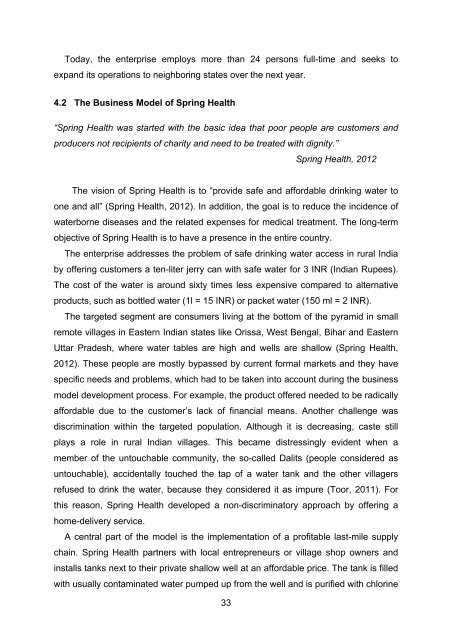Social Marketing for Safe Water
Download Study Springhealth - Market approaches to development
Download Study Springhealth - Market approaches to development
You also want an ePaper? Increase the reach of your titles
YUMPU automatically turns print PDFs into web optimized ePapers that Google loves.
Today, the enterprise employs more than 24 persons full-time and seeks toexpand its operations to neighboring states over the next year.4.2 The Business Model of Spring Health“Spring Health was started with the basic idea that poor people are customers andproducers not recipients of charity and need to be treated with dignity.”Spring Health, 2012The vision of Spring Health is to “provide safe and af<strong>for</strong>dable drinking water toone and all” (Spring Health, 2012). In addition, the goal is to reduce the incidence ofwaterborne diseases and the related expenses <strong>for</strong> medical treatment. The long-termobjective of Spring Health is to have a presence in the entire country.The enterprise addresses the problem of safe drinking water access in rural Indiaby offering customers a ten-liter jerry can with safe water <strong>for</strong> 3 INR (Indian Rupees).The cost of the water is around sixty times less expensive compared to alternativeproducts, such as bottled water (1l = 15 INR) or packet water (150 ml = 2 INR).The targeted segment are consumers living at the bottom of the pyramid in smallremote villages in Eastern Indian states like Orissa, West Bengal, Bihar and EasternUttar Pradesh, where water tables are high and wells are shallow (Spring Health,2012). These people are mostly bypassed by current <strong>for</strong>mal markets and they havespecific needs and problems, which had to be taken into account during the businessmodel development process. For example, the product offered needed to be radicallyaf<strong>for</strong>dable due to the customer’s lack of financial means. Another challenge wasdiscrimination within the targeted population. Although it is decreasing, caste stillplays a role in rural Indian villages. This became distressingly evident when amember of the untouchable community, the so-called Dalits (people considered asuntouchable), accidentally touched the tap of a water tank and the other villagersrefused to drink the water, because they considered it as impure (Toor, 2011). Forthis reason, Spring Health developed a non-discriminatory approach by offering ahome-delivery service.A central part of the model is the implementation of a profitable last-mile supplychain. Spring Health partners with local entrepreneurs or village shop owners andinstalls tanks next to their private shallow well at an af<strong>for</strong>dable price. The tank is filledwith usually contaminated water pumped up from the well and is purified with chlorine33



